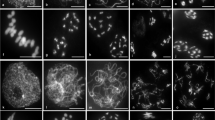Abstract
The chromosomes of Lolium temulentum are longer and contain on average 50% more nuclear DNA than the chromosomes of L. perenne. In the hybrid, despite the difference in length and DNA content, pairing between the homoeologous chromosomes at pachytene is effective and the chiasma frequency at first metaphase in pollen mother cells is high, about 1.6 per bivalent, comparable to that in the L. perenne parent. Electron microscopic observations from reconstructed nuclei at pachytene show that synaptonemal complex (SC) formation in 40% of bivalents is “perfect,” complete and continuous from telomere to telomere. In others, SCs extend from telomere to telomere but incorporate lateral component loops in interstitial chromosome segments. Even in these bivalents, however, pairing is effective in the sense of chiasma formation. The capacity to form “perfect” SCs is achieved by an adjustment of chromosome length differences both before and during synapsis. “Perfect” pairing and SC formation is commoner within the larger bivalents of the complement. At zygotene, in contrast to pachytene, pairing is not confined to homoeologous chromosomes. On the contrary there is “illegitimate” pairing between non-homologous chromsomes resulting in multivalent formation. There must, therefore, be a mechanism operative between zygotene and pachytene that corrects and modifies associations in such a way as to restrict the pairing to bivalents comprised of strictly homoeologous chromosomes. Such a correction bears comparison with that known to apply in allopolyploids. In the hybrid and in the L. perenne parent also, certain specific nucleolar organisers are inactivated at meiosis.
Similar content being viewed by others
References
Evans GM, Macefield AJ (1973) The effect of B chromosomes on homoeologous pairing in species hybrids. I. Lolium temulentum × Lolium perenne. Chromosoma 41:63–73
Hobolth P (1981) Chromosome pairing in allohexaploid wheat var. Chinese Spring. Transformation of multivalents into bivalents, a mechanism for exclusive bivalent formation. Carlsberg Res Commun 46:129–173
Holm PB (1977) Three-dimensional reconstruction of chromosome pairing during the zygotene stage of meiosis in Lilium longiflorum (Thunb). Carlsberg Res Commun 42:103–151
Hutchinson J, Rees H, Seal AG (1979) An assay of the activity of supplementary DNA in Lolium. Heredity 43:411–421
Jenkins G (1983) Chromosome pairing in Triticum aestivum cv. Chinese Spring. Carlsberg Res Commun 48:255–283
Jenkins G, Rees H (1983) Synaptonemal complex formation in a Festuca hybrid. In: Brandham PE, Bennett MD (eds) Kew chromosome conference II. George Allen and Unwin, London, pp 233–242
McClintock B (1933) The association of non-homologous parts of chromosomes in the mid-prophase of meiosis in Zea mays. Z Zellforsch Mikrosk Anat 19:191–237
Moses MJ, Poorman PA (1981) Synaptonemal complex analysis of mouse chromosome rearrangements. II. Synaptic adjustment in a tandem duplication Chromosoma 81:519–535
Navashin M (1934) Chromosome alterations caused by hybridization and their bearing upon certain general genetic problems. Cytologia 5:169–203
Rees H, Jones GH (1967) Chromosome evolution in Lolium. Heredity 22:1–18
Rees H, Jenkins G, Seal AG (1984) Quantitative DNA variation and chromosome homology. In: Evans CW, Dickinson HG (eds) Controlling events in meiosis. Company of Biologists Ltd., Cambridge, pp 321–331
Riley R, Chapman V (1958) Genetic control of the cytologically diploid behaviour of hexaploid wheat. Nature 182:713–715
Seal AG, Rees H (1982) The distribution of quantitative DNA changes associated with the evolution of diploid Festuceae. Heredity 49:179–190
Spurr AR (1969) A low-viscosity epoxy resin embedding medium for electron microscopy. J Ultrastruct Res 26:31–43
Taylor IB, Evans GM (1977) The genotypic control of homoeologous chromosome association in Lolium temulentum × Lolium perenne interspecific hybrids. Chromosoma 62:57–67
Wells B (1974) A convenient technique for the collection of ultrathin sections. Micron 5:79–81
Author information
Authors and Affiliations
Rights and permissions
About this article
Cite this article
Jenkins, G. Synaptonemal complex formation in hybrids of Lolium temulentum × Lolium perenne (L.). Chromosoma 92, 81–88 (1985). https://doi.org/10.1007/BF00328459
Received:
Issue Date:
DOI: https://doi.org/10.1007/BF00328459




